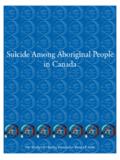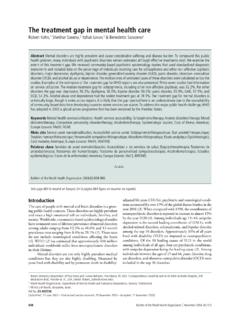Transcription of Namibia - who.int
1 2005 World Health OrganizationMental Healthatlas330N RNamibiaGENERAL INFORMATIONN amibia is a country with an approximate area of 824 thousand sq. km. (UNO, 2001). Its population is million, and the sex ratio (men per hundred women) is 96 (UNO, 2004). The proportion of population under the age of 15 years is 43% (UNO, 2004), and the proportion of population above the age of 60 years is 6% (WHO, 2004). The literacy rate is for men and for women (UNESCO/MoH, 2004).The country is a lower middle income group country (based on World Bank 2004 criteria). The proportion of health budget to GDP is 7%. The per capita total expenditure on health is 342 international $, and the per capita government expenditure on health is 232 international $ (WHO, 2004).The main language(s) used in the country is (are) Afrikaans, German and English.
2 The largest ethnic group(s) is (are) African (Ovambo, Kavango, Herero, Damara, Nama, Afrikaners), and the other ethnic group(s) are (is) Asian (descent). The largest religious group(s) is (are) indigenous groups, and the other religious group(s) are (is) life expectancy at birth is years for males and years for females (WHO, 2004). The healthy life expectancy at birth is 43 years for males and 44 years for females (WHO, 2004). EPIDEMIOLOGYT here is a paucity of epidemiological data on mental illnesses in Namibia in internationally accessible HEALTH RESOURCESM ental Health Policy A mental health policy is final draft of the mental health policy is ready and has been submitted for Abuse Policy A substance abuse policy is absent. The final draft of the substance abuse policy is ready and has been submitted for Mental Health Programme A national mental health programme is mental health programme was drafted with assistance of WHO.
3 It will be presented to the Primary Health Care Management Committee for final inputs and then it will be forwarded for Therapeutic Drug Policy/Essential List of Drugs A national therapeutic drug policy/essential list of drugs is present. It was formulated in Health Legislation Mental health services are provided under the South African Mental Health Act no. 18 of 1973. This is in spite of the fact that the South African Mental Health Act has been updated in South Africa. Namibia is therefore using an out-dated legislation. A new Bill is in the early stages of development. This is an essential element of reform that is needed as part of the implementation of the Mental Health latest legislation was enacted in Health Financing There are no budget allocations for mental about expenditure on mental health are not primary sources of mental health financing in descending order are tax based, grants, out of pocket expenditure by the patient or family and private has no cost recovery mechanisms in place.
4 As a result of this, incomes generated by health services through user fees, insurance recovery and donations are deposited in the general revenue of the Government. The Ministry of Health is currently exploring possibilities regarding retaining a portion of the collected fees. Mental health is under the primary health care programme and there is no special budget for mental health. The budget is allocated according to the annual mental health country has disability benefits for persons with mental disorders. If a person is classified as chronically mentally ill then the appli-cation is forwarded to the social services for disability Health Facilities Mental health is a part of primary health care system. Actual treatment of severe mental disorders is not available at the primary level.
5 Treatment is generally available at the hospital level, but follow-up of discharged psychiatric patients is done in all health care training of primary care professionals is not carried out in the field of mental health. There is a proposal to train more mental health nurses and social workers. Community psychiatric nurses based in state hospitals also run satellite psychiatric clinics. However, such services are not available in the interior. Nurses cannot prescribe medication, for which they have to consult medical officers or psychiatrists. The psychiatric unit in the country s capital also plans to identify medical officers with interest in psychiatry and provide them with one-week intensive training followed by on-site basic psychiatry training. Traditional healers are also being encouraged to undertake training, and depot anti-psychotics are provided to them for managing psychotic disorders.
6 The Namibia University has no medical school. The general nursing training includes a component of psychiatric are community care facilities for patients with mental disorders. Only follow-up of discharged psychiatric patients is done in the community. 2005 World Health OrganizationMental Healthatlas331N RPsychiatric Beds and ProfessionalsTotal psychiatric beds per 10 000 population beds in mental hospitals per 10 000 population beds in general hospitals per 10 000 population 0 psychiatric beds in other settings per 10 000 population 0 Number of psychiatrists per 100 000 population of neurosurgeons per 100 000 population 0 Number of psychiatric nurses per 100 000 population 0 Number of neurologists per 100 000 population 0 Number of psychologists per 100 000 population 6 Number of social workers per 100 000 population 6 The above mentioned psychologists and social workers work in the public sector.
7 Two occupational therapists are working in Windhoek Mental Health Care Centre. A relatively broad range of mental health services are currently available only at tertiary care centres (Windhoek Mental Health Care Centre with 112 beds and Oshakati psychiatric Unit with 80 beds). Emergency mental health services are also provided at the district hospitals as part of general wards (which do not have specialist mental health staff). All gen-eral hospitals are expected to have at least one or two rooms for severely psychotic patients. Follow-up and a limited range of psy-chotropic medications are available at some health care centres and clinics. Ninety-nine beds at the Windhoek Mental Health Care Centre are earmarked for forensic psychiatry services. At present, the referral system is not well established.
8 The responsible doctors follow referral guidelines sent out to all regions for mentally ill patients for at least 72 hours. However, health professionals at these levels find it hard to adhere to these guidelines due to their limited training and experience in mental health areas. Even the special-ized mental health centres lack the full complement of mental health professionals in terms of specialization and numbers. Recently, one registered nurse from Windhoek psychiatric centre completed her degree in psychiatric nursing with the financial support from Finland. A major portion of psychiatric care in primary and secondary care settings is provided by nurses and social workers, due to lack of trained psychiatrists. Private practitioners also provide mental health services (10 psychologists, 3 psychiatrists), but these services are limited to those who can afford them.
9 Traditional healers also play a considerable role, however, the number of those mentally ill individuals seeking the services in this sector is Organizations NGOs are involved with mental health in the country. They are mainly involved in advocacy, promotion, prevention and rehabilitation. In the capital city, the German Evangelic Lutheran Church provides one accommodation facility for psychiatric patients who do not have a family to take care of Gathering System There is mental health reporting system in the country. The Health Information System was revised in 2000, and new system was introduced in 2001. The analyses are based on the records of outpatients who attended clinics, health centres and hospital outpatient departments. Information on inpatients is also available.
10 The facility based information contains data on all public health sectors and services including mission health care facilities. Mental illnesses are audited if they are among the first ten common country has data collection system or epidemiological study on mental health. Disorders are classified according to ICD 10 for Special Population The country has specific programmes for mental health for children. The Windhoek Mental Health Care Centre provides outpatient and inpatient services for Drugs The following therapeutic drugs are generally available at the primary health care level of the country: car-bamazepine, phenobarbital, phenytoin sodium, sodium, valproate, amitriptyline, chlorpromazine, diazepam, fluphenazine, haloperi-dol, lithium, biperiden, carbidopa, Namibian Essential Medicines List (NEMLIST) has been formulated.













